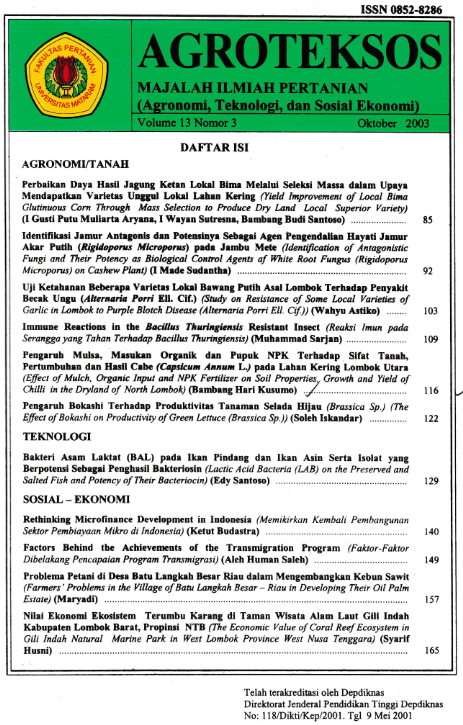5. PENGARUH MULSA, MASUKKAN ORGANIK DAN PUPUK NPK TERHADAPSIFAT TANAH, PERTUMBUHAN DAN HASIL CABE (CAPSICUM ANNUM L.) PADA LAHAN KERING LOMBOK UTARA EFFECT OF MULCH, ORGANIC INPUT AND NPK FERTILIZER ON SOIL CHARACTERISTIC, GROWTH AND YIELD OF CHILLI - CAPSICUM ANNUM L.,IN DRYLAND NORTH LOMBOK
Main Article Content
Abstract
Pemenuhan permintaan pasar akan cabe, dapat diupayakan melalui peningkatan produksi komoditi di lahan kering. Berkaitan adanya faktor pembatas lahan kering yang berkaitan dengan sifat tanah dan iklimn, maka diperlukan teknik budidaya cabe yang berbeda dengan lahan basah. Untuk mengatasi faktor pembatas tersebut antara lain ditempuh melalui pemanfaatan mulsa dan pupuk organik yang dipadu dengan pupuk anorganik. Penelitian ini bertujuan untuk mengetahui pengaruh mulsa,masukkan organik, dan pemberian pupuk NPK terhadap bebrapa sifat tanah, pertumbuhan, dan hasil cabe. Penelitian dilaksanakan di lahan kering Amor-Amor Lombok Utara, dengan menerapkan rancangan acak kelompok lengkap yang ditata secara faktorial (3 x 3) dengan tiga ulangan. Faktor pertama Mulsa (M) yang terdiri dari 3 aras, yaitu M1 = Tanpa mulsa, M2 = mulsa jerami padi + tanaman legum, M3 = mulsa plastik perak hitam, dan faktor kedua Masukkan organik (pupuk kandang) dan pupuk NPK (O) yang terdiri atas 3 aras; O1= 5 ton per ha + (150 kg urea + 300 kg TSP + 262,5 kg KCl per ha), 02 = 10 ton per ha + (100 Kg urea + 150 kg TSP + 175 kg KCl per ha), 03 = 15 ton per ha + (50 kg urea + 100 kg TSP + 87,5 kg KCL per ha). Cabe yang ditanam adalah varietas Hot Beauty. sil penelitian menunjukkan bahwa peningkatan dosis pupuk organik yang dibarengi dengan pengurangan pupuk anorganik sampai batas tertentu dalam satu paket pemupukan, berperan dalam meningkatkan kadar bahan organik dan KTK tanah, disamping itu berperan pula menurunkan nilai BV dan permeabilitas tanah. Macam mulsa tidak berpengaruh nyata terhadap sifat tanah. Perlakuan pupuk organik dan anorganik dengan kadar total unsur hara yang relatif sama tidak berpengaruh terhadap pertumbuhan cabe, tetapi berpengaruh terhadap hasil cabe. Selain itu, mulsa plastik perak hitam dan mulsa jerami padi + tanaman legum, berpengaruh lebih baik terhadap produksi cabe daripada tanpa mulsa.
ABSTRACT
To meet demand on chilli, efforts to improve production of the commodity have been carried out through utilisation of dryland. Concerning the limiting factors of dryland relating to the soil characteristics and climate, specific technique of chilli cropping system is required which is difference from that in wetland. An effort aimed to overcome the limiting factors through the use of mulch, and application of organic and inorganic fertilisers. The objective of the research is to determine the effects of mulch, organic input, and NPK application on soil characteristics, the growth and yield of chilli. he research was carried out in a dryland of Amor-Amor, North Lombok, by applying a field experiment randomised completely block design arranged using factorial (3 x 3) with 3 replications. The first factor was mulch (M) consisting of 3, namely M1 = no mulch, M2 = rice straw mulch, and M3 = plastic mulch. The second factor was organic input OM + NPK (O), consisting of 3 levels, O1 = 5 ton OM + 150 kg Urea + 300 kg TSP + 162,5 kg KCl per ha, O2 = 10 ton OM + 100 kg Urea + 150 kg TSP + 175 KCl per ha, and O3 = 15 ton OM + 50 kg Urea + 100 kg TSP + 87,5 kg KCl per ha. The crop was chilli of Hot Beauty. sult indicates that the increase of organic input, incorporate with decrease inorganic fertilisers up to certain level of fertilisation package, could increase the content of soil organic matter and CEC, but decrease soil bulk density and permeability. Type of mulch did not significantly affect soil characteristics. Organic and inorganic fertiliser did not significantly affect crop growth, but yield. The plastic mulch and rice straw + legumes mulch had a better effect on yield of chilli than that of without mulch.

